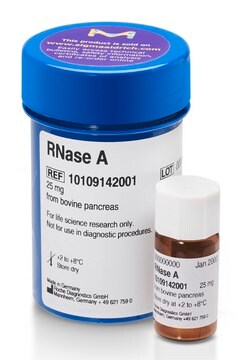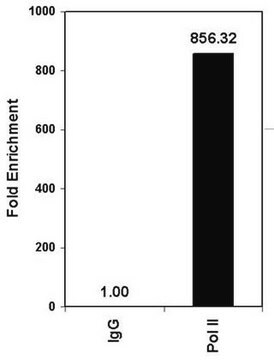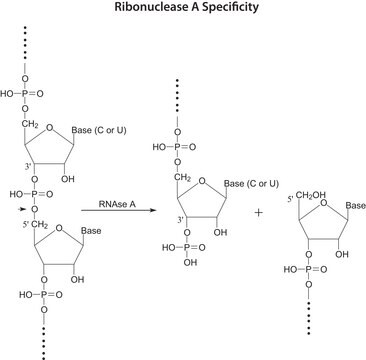17-630
ChIPAb+ Acetyl-Histone H4 - ChIP Validated Antibody and Primer Set
serum, from rabbit
Sign Into View Organizational & Contract Pricing
All Photos(3)
About This Item
UNSPSC Code:
12352203
eCl@ss:
32160702
NACRES:
NA.52
clone:
polyclonal
application:
ChIP
IP
WB
cell based assay
multiplexing
IP
WB
cell based assay
multiplexing
species reactivity:
eukaryotes, human
technique(s):
ChIP: suitable
cell based assay: suitable
immunoprecipitation (IP): suitable
multiplexing: suitable
western blot: suitable
cell based assay: suitable
immunoprecipitation (IP): suitable
multiplexing: suitable
western blot: suitable
citations:
19
Recommended Products
biological source
rabbit
Quality Level
antibody form
serum
clone
polyclonal
species reactivity
eukaryotes, human
manufacturer/tradename
ChIPAb+
Upstate®
technique(s)
ChIP: suitable
cell based assay: suitable
immunoprecipitation (IP): suitable
multiplexing: suitable
western blot: suitable
NCBI accession no.
UniProt accession no.
shipped in
dry ice
General description
All ChIPAb+ antibodies are individually validated for chromatin precipitation, every lot, every time. Each ChIPAb+ antibody set includes control primers (tested every lot by qPCR) to biologically validate your IP results in a locus-specific context. The qPCR protocol and primer sequences are provided, allowing researchers to validate ChIP protocols when using our antibody in their chromatin context. Each set also includes a negative control antibody to ensure specificity of the ChIP reaction.
The ChIPAb+ Acetyl-Histone H4 set includes purified rabbit polyclonal antiserum and the normal rabbit IgG antiserum, which can be used to demonstrate that the acetyl-histone H4 antibody is capable of precipitating acetyl-histone H4 associated chromatin. The qPCR primers included flank the human GAPDH promoter and produce a 166 base pair PCR product.
The ChIPAb+ Acetyl-Histone H4 set includes purified rabbit polyclonal antiserum and the normal rabbit IgG antiserum, which can be used to demonstrate that the acetyl-histone H4 antibody is capable of precipitating acetyl-histone H4 associated chromatin. The qPCR primers included flank the human GAPDH promoter and produce a 166 base pair PCR product.
Specificity
Predicted broad cross-reactivity among eukaryotes based upon sequence similarity.
Recognizes acetylated histone H4 of approximately 10 kDa. Cross-reacts with acetylated histone H2B from Tetrahymena and weakly crossreacts with acetylated histone H2B from HeLa cells.
May cross-react with other acetylated proteins.
May cross-react with other acetylated proteins.
Immunogen
The acetyl-histone H4 antiserum is made against a peptide corresponding to amino acids 2-19 of Tetrahymena histone H4.
Application
Research Category
Epigenetics & Nuclear Function
Epigenetics & Nuclear Function
Research Sub Category
Histones
Histones
This ChIPAb+ Acetyl-Histone H4 -ChIP Validated Antibody & Primer Set conveniently includes the antibody & the specific control PCR primers.
Western Blot Analysis:
Acidextracted proteins from normal HeLa cells (Lane 1) and HeLa cells treated with 5 mM sodium butyrate for 24 hours (Lane 2) were resolved by electrophoresis, transferred to nitrocellulose and probed with anti-acetyl Histone H4 (1:2000).
Proteins were visualized using a goat-anti rabbit secondary antibody conjugated to HRP and a chemi-luminescence detection system. (Please see figures).
Acidextracted proteins from normal HeLa cells (Lane 1) and HeLa cells treated with 5 mM sodium butyrate for 24 hours (Lane 2) were resolved by electrophoresis, transferred to nitrocellulose and probed with anti-acetyl Histone H4 (1:2000).
Proteins were visualized using a goat-anti rabbit secondary antibody conjugated to HRP and a chemi-luminescence detection system. (Please see figures).
Packaging
25 assays per set. ~4 μL per chromatin immunoprecipitation
Quality
Chromatin Immunoprecipitation:
Sonicated chromatin prepared from untreated HeLa cells (1 X 106 cell equivalents) was subjected to chromatin immunoprecipitation using 4 μL of either a normal rabbit antiserum or Anti-Acetyl Histone
H4 serum and the Magna ChIP A (Cat. # 17-610) Kit. Successful immunoprecipitation of acetyl histone H4 associated DNA fragments was verified by qPCR using control ChIP Primers flanking the human GAPDH promoter (Please see figures).
Please refer to the EZ-Magna A ChIP (Cat. # 17-408) or EZ-ChIP (Cat. # 17-371) protocol for experimental details.
Sonicated chromatin prepared from untreated HeLa cells (1 X 106 cell equivalents) was subjected to chromatin immunoprecipitation using 4 μL of either a normal rabbit antiserum or Anti-Acetyl Histone
H4 serum and the Magna ChIP A (Cat. # 17-610) Kit. Successful immunoprecipitation of acetyl histone H4 associated DNA fragments was verified by qPCR using control ChIP Primers flanking the human GAPDH promoter (Please see figures).
Please refer to the EZ-Magna A ChIP (Cat. # 17-408) or EZ-ChIP (Cat. # 17-371) protocol for experimental details.
Target description
10 kDa
Physical form
Anti-Acetyl-Histone H4 (rabbit polyclonal IgG). One vial containing 100 μL of antiserum containing 0.05% sodium azide. Store at -20°C.
Normal Rabbit Serum. One vial containing 100 uL antiserum containing 0.05% sodium azide. Store at -20°C.
Control Primers. One vial containing 75 μL of 5 μM of each primer specific for for human GAPDH.
Normal Rabbit Serum. One vial containing 100 uL antiserum containing 0.05% sodium azide. Store at -20°C.
Control Primers. One vial containing 75 μL of 5 μM of each primer specific for for human GAPDH.
Storage and Stability
Stable for 1 year at -20°C from date of receipt.
Analysis Note
Control
Included negative control rabbit IgG antiserum and control primers specific for human GAPDH promoter.
Included negative control rabbit IgG antiserum and control primers specific for human GAPDH promoter.
Legal Information
UPSTATE is a registered trademark of Merck KGaA, Darmstadt, Germany
Disclaimer
Unless otherwise stated in our catalog or other company documentation accompanying the product(s), our products are intended for research use only and are not to be used for any other purpose, which includes but is not limited to, unauthorized commercial uses, in vitro diagnostic uses, ex vivo or in vivo therapeutic uses or any type of consumption or application to humans or animals.
Storage Class Code
10 - Combustible liquids
Certificates of Analysis (COA)
Search for Certificates of Analysis (COA) by entering the products Lot/Batch Number. Lot and Batch Numbers can be found on a product’s label following the words ‘Lot’ or ‘Batch’.
Already Own This Product?
Find documentation for the products that you have recently purchased in the Document Library.
Rosita Accardi et al.
Carcinogenesis, 36(11), 1440-1451 (2015-10-02)
Although Epstein-Barr virus (EBV) infection is widely distributed, certain EBV-driven malignancies are geographically restricted. EBV-associated Burkitt's lymphoma (eBL) is endemic in children living in sub-Saharan Africa. This population is heavily exposed to food contaminated with the mycotoxin aflatoxin B1 (AFB1).
Chunjian Huang et al.
Journal of immunology (Baltimore, Md. : 1950), 190(9), 4470-4473 (2013-04-02)
Regulatory T cells (Tregs) play a pivotal role in the maintenance of immunological self-tolerance. Deficiency or dysfunction of Tregs leads to severe autoimmune diseases. Although the forkhead/winged-helix family member FOXP3 is critical for Treg differentiation and function, the molecular basis
Rosita Accardi et al.
PLoS pathogens, 9(3), e1003186-e1003186 (2013-03-22)
Many studies have proved that oncogenic viruses develop redundant mechanisms to alter the functions of the tumor suppressor p53. Here we show that Epstein-Barr virus (EBV), via the oncoprotein LMP-1, induces the expression of ΔNp73α, a strong antagonist of p53.
Y Y Lee et al.
Cell death and differentiation, 20(7), 941-952 (2013-04-13)
Catecholamines regulate the β-adrenoceptor/cyclic AMP-regulated protein kinase A (cAMP/PKA) pathway. Deregulation of this pathway can cause apoptotic cell death and is implicated in a range of human diseases, such as neuronal loss during aging, cardiomyopathy and septic shock. The molecular
Dandan Niu et al.
Cancers, 2(3), 1689-1704 (2010-01-01)
Deleted in Lung and Esophageal Cancer 1 (DLEC1) is a functional tumor suppressor gene (TSG). It has been found to be silenced in a variety of human cancers including hepatocellular carcinoma (HCC). The silencing of DLEC1 can be modulated by
Our team of scientists has experience in all areas of research including Life Science, Material Science, Chemical Synthesis, Chromatography, Analytical and many others.
Contact Technical Service






